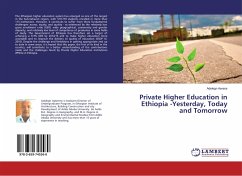The Ethiopian higher education system has emerged as one of the largest in the Sub-Saharan region, with 519,770 students enrolled in more than 113 institutions. However, it continues to suffer from three fundamental challenges- access, equity, and quality - as evidenced by the relatively low gross enrollment ratio (GER), wide geographical, community and gender disparity, and relatively low level of competence of graduates in some fields of study. The Government of Ethiopia has therefore set a target of achieving a 9.3% GER by 2014/15 and to make higher education more accessible and to improve the delivery of quality of education (ESDP IV, 2010). Despite the challenge and limitations in getting appropriate and up to date in some areas, it is hoped that this paper, the first of its kind in the country, will contribute to a better understanding of the contributions made and the challenges faced by Private Higher Education Institutions (PHEIs) in Ethiopia.








